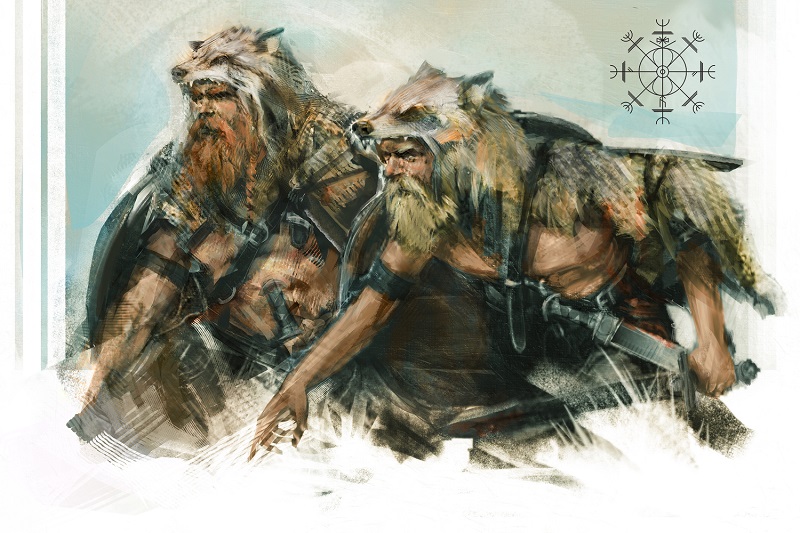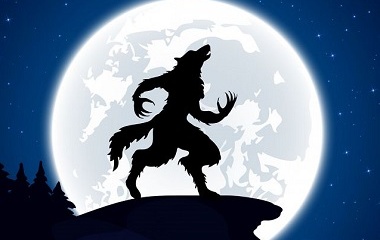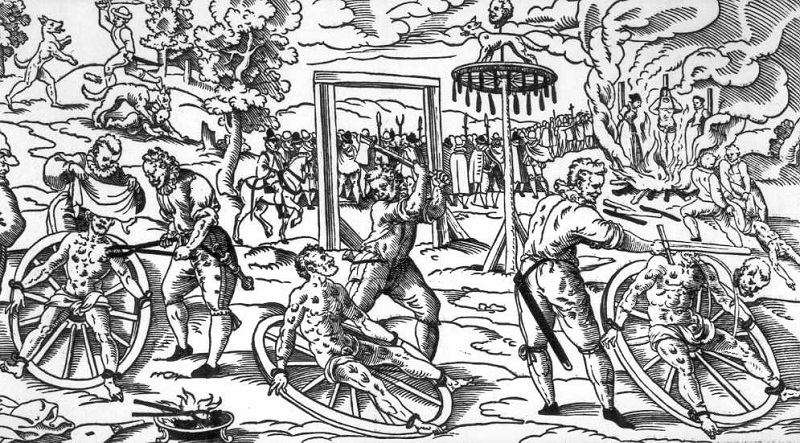Werewolves have been part of European folklore for centuries, but they caught on in popularity when citizens were put on trial for ‘wolf charming’ and lycanthropy in the later end of the Middle Ages.
What is a Werewolf?
A werewolf is a man that has been cursed or charmed into a beast that hunts at night and craves human flesh. The word ‘werewolf’ literally translates to man-wolf (‘were’ meaning man). There are many ways in which this transformation could occur.
Many legends claim that a man would transform into a werewolf if he was bitten or scratched by another werewolf in its animal form. There are also accounts of children who were cursed to hunt as werewolves if they grew up in abusive homes.
There are many records of people willingly transforming into werewolves. One of the most common claims for being able to transform into the beast was for a person to remove all of their clothing and wear a belt made of wolfskin. Similar stories hold the same as being true for individuals that wore the entire wolfskin. In both of these cases, the werewolf would need to find their clothing again to transform back into a human.
There are also tales of magic salves that could transform a person. Other sources tell of enchanted streams that gave people the ability to transform. Other transformation rituals include drinking rainwater out of the footprint of a wolf and sleeping with the light of a full moon on one’s face during a Wednesday or Friday summer night.
Possible Connection to Christianity
Many areas where Christianity was the dominant religion tell of werewolf transformations through an alliance with the Devil. Many historians believe this was a way to explain the violent and cannibalistic impulses of predatory serial killers in the Middle Ages. Religious cultures sometimes explained werewolf transformations as being a divine punishment from God himself. In fact, those who were excommunicated from the Roman Catholic Church were said to be cursed with werewolfism.
Although werewolf transformation was thought to be a terrible curse, there were remedies that were rumored to cure the afflicted person. Some cultures believed extreme bouts of exercise would be enough to cure an afflicted individual. Others thought that striking a werewolf on the scalp with a knife was enough to stop the transformation. There are also reports of piercing a werewolf’s hands with nails to produce a cure.
In Europe, where werewolf lore became most popularized, it was thought that there were three ways to cure werewolf transformation: with wolfsbane (a poisonous plant), surgery, or exorcism. Unfortunately, many of the supposed cures that were supported by Europe’s early doctors killed the majority of patients.
German lore proves to be much less violent – to cure an afflicted person, one must simply call the werewolf by its Christian name three times.
Characteristics
Physical Description
With the search for werewolves in the Middle Ages as paranoia about witches and other such creatures was heightened by the Church, people began searching for tell-tale signs that an individual could be a potential werewolf.

One of the most common identifiers of a supposed werewolf was a unibrow. Other signs included curved fingernails (similar to claws), lower-than-normal ears, and a swinging stride that resembled that of a wolf.
If an individual was identified as a potential werewolf, they were often subjected to tests to see if the accusations against them could hold up. One of the most common tests was to cut the skin of the accused to see if fur could be found underneath the wound. Russian folklore also claims that werewolves had bristles underneath their tongues that couldn’t be found on normal human beings.
When werewolves were in their animal form, it is said that there are surprisingly few differences between the creature and an actual wolf. One of the biggest indicators of a werewolf would be the absence of a tail – though Swedish folklore suggests that some werewolves ran on three legs and held their fourth leg out behind them to appear like a normal wolf from a distance. It was also thought that werewolves had human eyes and voices.
One of the easiest ways to identify a suspected werewolf was to try to injure the werewolf with a mark that would be easily identifiable. It was believed that when a werewolf was injured in animal form, the same injury would manifest itself in the being’s human form.
Personality
One of the most common themes of werewolves is their craving for human flesh. At night, these creatures are said to hunt for victims in order to sate their deep hunger.
There are many different versions and variations of werewolves, but many of these stories involve the transformation of a sinner into a wolf. There are several sources that specify that a person who was guilty of committing a deadly sin would be cursed to turn into a werewolf by night for seven years. Many of these variations specify that werewolves preferred to eat children, though there are plenty of tales that suggest werewolves choose their victims indiscriminately.
There are also tales that suggest that werewolves could be spotted in their human form by their uncontrollable rage. This is perhaps influenced by the Ulfheonar – a Norse cult that worshiped the wolf and made it their ultimate goal in life to shapeshift into a wolf. These fierce warriors adopted all of the traits of their patron an lived in the woods. They were thought to be immune to iron and fire when fighting and were similar to the Berserkers in their manner and practices.
When it comes to Lycanthropes, many people believe that their claim to turn into wolves or other beasts was partially fueled by their violent and cannibalistic tendencies. Some historians believe that some of the lycanthropes that were persecuted in history were actually serial killers that were rationalized into something easier to understand by the public.
Werewolves vs Lycanthropes
You’ve probably heard of a lot of instances in which the word ‘werewolf’ was used synonymously with ‘lycanthrope.’ While some people use the word interchangeably, they actually have two very different meanings.
A werewolf refers to the idea of a person being able to transform themselves into a wolf and assume wolf-like mannerisms. While the existence of werewolves has never been proven, they are common in folklore around the world – especially in Europe.
A lycanthrope, on the other hand, is simply a person that thinks they have the ability to transform into a wolf or other animal species. These individuals often have other disturbing symptoms such as psychosis or a strange craving for human flesh. It is thought that some individuals with lycanthropy believe they have the ability to transform into a werewolf because they need internal justification for their violent tendencies or cannibalistic desires.
Famous Werewolves
Peter Stumpp
Peter Stumpp had the misfortune of having one of the most famous werewolf trials of his time. Stump was tried for werewolf transformation during 1589 and was put on trial before his town. Because the town felt they had enough evidence against him, this trial mainly consisted of torture.
Stumpp was connected to the werewolf of Bedburg because of his notable disability – a missing left hand. It had been reported that the werewolf of Bedburg had a missing left paw and since it was believed that the injuries of the werewolf manifested themselves in both wolf and human form, Stumpp was quickly charged.
The trial commenced with Stumpp being stretched out on a rack and having chunks of his flesh ripped out with searing hot pincers. His bones were also crushed with stones to ensure that the great pain he suffered was enough to convince him to ‘confess’ of all his sins.
Stumpp confessed to everything he was accused of. He alleged that he had been practicing black magic since the age of 12 and had been assuming the form of a werewolf for at least 25 years. During this time, he confessed to killing and eating both livestock and humans. Most notably, he admitted to killing and eating 14 children and 2 pregnant women.
Aside from all of the innocent women and children he supposedly ate and was forced to confess guilt over, he was also accused of having incestuous relationships with his daughter and a distant relative. He confessed to these misdeeds as well, which resulted in both unlucky women being executed along with him. They were promptly ‘flayed’ and strangled to death.
After the crowd was finally satisfied with the suffering of Peter Stumpp, he was beheaded and his body – along with the body of his daughter and mistress – were burned for all to see. His severed head was placed on a torture wheel and an image of a wolf was attached and displayed in the city center to serve as a reminder to the rest of the townspeople.
Some historians believe that Peter Stumpp was not actually a werewolf, but was tried by the Church as a way to send a message to recently converted Protestants. Stumpp had converted to Protestant beliefs in earlier years during a war that was waged between the Protestants and the Catholics. It is thought that the Catholics may have accused Stumpp so they could persuade other converts to reconsider their change in religion – or suffer the same fate. They cite the attendance of aristocracy at the trial and execution as evidence that something more than witchcraft was a work. Furthermore, it appears that Peter Stumpp was the only werewolf convicted in Bedburg, though werewolf trials usually ended in the conviction of a pack that supposedly hunted together.
Hans the Werewolf
The trial of ‘Hans the Werewolf’ is often pointed to in order to demonstrate the tendency of the courts to charge individuals for both werewolf transformations and witchcraft.
In the year 1651, young Hans was brought before his city’s court and charged with being a werewolf. He was questioned so the court could determine the seriousness of the offense and was said to have given up valuable information.
Hans claimed that he had received a wolf’s skin from a strange man in black and had used it to hunt for two years. He confirmed that he was actually able to transform into a wolf instead of merely entering the wolf’s body which the court decided was ‘magical transformation.’
The court also became convinced that the man in black was the devil, which meant Hans was guilty of both witchcraft and werewolf transformation. He was found guilty and sentenced to death.
Thiess
In 1692, an unusual case presented itself to the courts in Livonia. An 80-year-old man by the name of Thiess was accused of being a werewolf. He confessed to the crime of werewolf transformation, but gave the courts an unexpected twist.
Thiess claimed that he was transformed into a werewolf through the power of God and he, along with several other werewolves, descended into Hell three times a year to fight Satan’s demons. Thiess claimed that this was done in order to ensure a good harvest.
The court tried to make Thiess confess to witchcraft and werewolf transformation through a pact with the devil, but he was firm in his answer. Although the court couldn’t find Thiess guilty of witchcraft or allegiance to the Devil, he was sentenced to whipping in October of 1692.
Werewolves and Revenants
At the end of the 1800’s a new belief came into existence – revenants. Revenants were supposedly werewolves that were not destroyed properly and came back from the dead. They were thought to roam battlefields and drink the blood of the dead and dying.
In Northern Europe, some people believed that people who died in mortal sin came back as revenants. By night, they roamed and hunted as undead werewolves. By day, they returned to their human corpse form.
To kill a revenant, it was thought that the beast in question had to be decapitated with a spade. The heads of the revenants were then thrown into a river. It was thought that the weight of the sins of the revenant would keep the head at the bottom of the river and prevent them from coming back as again.
There were also some that believed revenants could be dealt with in the same manner as traditional vampires.
Possible Inspiration for the Werewolf Myths
Neuri
The Neuri were a tribe that lived north of the Tyres. They were said to be a tribe that had been driven from their original homeland due to an invasion of serpents. There are reports of a tale that claim the Neuri transformed into wolves once a year, though this is sometimes seen as a reference to their shamanic practices.
Lycaon
According to Greek mythology, Lycaon was a mortal who tried to test Zeus’ omniscience abilities. To see if Zeus really was all-powerful and all-knowing, Lycaon killed his own son and served his roasted flesh to Zeus.
Zeus knew what Lycaon had done and punished him for his terrible deeds by turning him into a wolf.
Ulfheonar

Of all the characters who could have inspired the tale of the werewolves, the Ulfheonar are the most likely candidates. The Ulfheonar were a group of elite Norse warriors that lived in the woods as a shamanic cult. Their patron animal was the wolf and it was said that the greatest of the Ulfheonar could actually transform into wolves during battle. Though the Ulfheonar were feared by all (including their kin), they were also greatly respected and considered to be Odin’s men.
Explanation of the Myth
There are many theories as to what or who may have inspired the myth of werewolves. Some scholars say the existence of some wolf-creature mythology was unavoidable in Europe because wolves were seen as one of the most fearsome predators of that time.
Others believe the fear of werewolf transformation could have simply been a misinterpretation of a medical condition. There are two diseases in particular that seem to be reasonable explanations for these stories – porphyria and hypertrichosis.
Porphyria is a condition that makes its sufferers extremely sensitive to sunlight and is characterized by reddish teeth, anxiety, seizures, and psychosis. Supporters of this theory claim people may have been frightened by those afflicted with porphyria because they would have only been active at night – making them prime suspects for werewolf transformation.
Others disagree with this analysis. While porphyria has all the expected symptoms of those guilty of werewolf transformation, it doesn’t explain why werewolves are described as resembling a wolf in physical form. Instead of porphyria serving as the cause of the alarm, they believe hypertrichosis is the cause of werewolf hysteria.
Hypertrichosis is a condition in which the afflicted person has excessive hair growth. This excessive hair could have cause afflicted individuals to appear like werewolves if they were seen at night. Others argue that this isn’t plausible because the rarity in which this disease occurs makes it unlikely that it could have been found with the same prevalence that werewolves were reported.
There are some that think werewolf transformation tales could have arose from the spread of rabies. Those who support this theory point to the fact that victims of rabies can pass the disease on to others if they bite another individual.
Regardless of how the tales of werewolf transformations came about, werewolves will remain as one of the most infamous folk tales that grew to become a global phenomenon.












